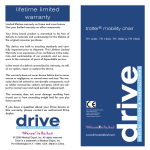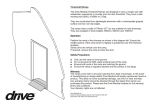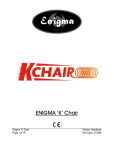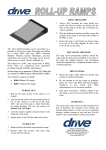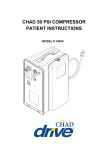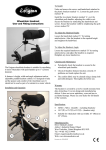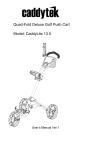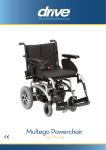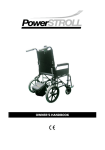Download User Manual
Transcript
warranty details Your Drive branded product is warranted to be free of defects in materials and workmanship for one year from date of purchase. This device was built to exacting standards and carefully inspected prior to shipment. This warranty is an expression of our confidence in the materials and workmanship of our products and our assurance to the customer. In the event of a defect covered by this warranty, we will at our option supply parts or replace the device. This warranty does not cover device failure due to owner misuse or negligence, or normal wear and tear. The warranty does not extend to non-durable components, such as rubber accessories, castors and grips, which are subject to normal wear and need periodic replacement. Steerable Knee Walker If you have any queries or require full warranty conditions, please contact your Drive stockist. This does not affect your statutory rights. Drive Medical Ltd Ainley’s Industrial Estate, Elland, West Yorkshire, GB HX5 9JP www.drivemedical.co.uk Document code: 790_Hangtag (Iss 09/14) www.drivemedical.co.uk Safety Precautions CAUTION: TO REDUCE THE RISK OF ACCIDENT Before using the Knee Walker, you should be trained by a healthcare professional or dealer. Engage the brakes and practice bending, reaching and transfers on and off the Knee Walker. DO NOT use the Knee Walker by yourself until you have been properly trained, you have practiced with someone and you feel confident you can maneuver by yourself. The use of the Knee Walker is individual to the person. You should develop your own methods for use based on your personal level of function and ability. Be aware of your surroundings when operating the Knee Walker. Look for hazards and avoid them. Examples of hazards include wet or slippy flooring, obstacles on the floor, and excessive gradients. Always ensure the seat and tiller are secure before load bearing use. The seat is only used to support a knee. Do not sit on the seat. Operating the Knee Walker The Drive Knee Walker is a mobility device that provides strength and comfort to anyone who may have an injury below the knee. It allows an even distribution of body weight by supporting half of the weight on the device and the other half on the noninjured leg. The device has a cushioned platform to support both the injured leg and ankle to make certain that no weight will be place on the lower leg. The device may also be used a technical aid for a disabled person who may have conditions including foot ulcers and lower leg amputation. The device is designed for easy steering and stopping. Brakes are also featured on this device for controlled movement and safety. Placement of the affected leg on the bench should be centered side to side and positioned forward to cover the full length of the bench. With the affected leg on the seat, stand as straight as possible (adjust the height of the tiller and seat if required). With the affected foot pointing down, the position of the propulsion leg should be maintained as close as possible to the seat. While on your toes, start out with small steps with the propulsion leg. Concentrate on keeping that leg next to the seat. With practice, you should be able to move forward without deviating to the opposite side. Assembly Instructions 1. Remove the contents from the carton. 4. Straighten the tiller to the upright position. Slide the second screw into the receptacle (figure 3). 2. Insert the front tiller in to the front of the frame (figure 1). 5. Secure the screw and tiller in place by pushing the locking handle against the side of the tiller (figure 4). 3. Once the tiller is in place and the handles are aligned correctly with the wheels, tighten the screw (figure 2) using an allen key by turning clockwise. 6. Insert the seat post in to the seat receptacle. Follow the instructions overleaf to install the seat. Seat Height Adjustment Seat lock knob correct Incorrect Turn the seat lock knob anticlockwise to release the seat post. Readjust the seat to the required height. Replace the Seat Lock Knob and turn clockwise to tighten, as shown above. Ensure the Seat Lock Knob fully goes through the seat post and the end of the Knob can be seen protruding through the other side (ringed above). Ensure the seat points forward as shown in the diagram. Handle Height Adjustment To adjust the handle height, release the lock tab on the collar and adjust the handle to the desired height. Push the lock tab back to tighten. To Fold the Tiller To fold the tiller down, pull the bottom lock lever away from the knee walker until the lock is disengaged. While holding the lock lever in the down position, fold the tiller down until it rests on the seat. Using the Hand Brake ! Do not use the Knee Walker if the brake system is not working properly. ! The Knee Walker’s brake is similar to a bicycle brake and also has a locking feature. ! To use the brake, simply pull the lever with your finger tips toward the handle bar. ! To lock the brake, pull the brake lever towards the handle bar and push down the spring loaded push button (located on top of the brake unit). When done correctly, the push button will remain down and the brake lever will be locked in place. Repeat for the other brake. ! To release the brake, simply pull the lever towards the handle bar. The push pin will release up automatically. Adjusting the Hand Brake ! For minor adjustment, the brake adjuster located on the handbrake can be turned out from the hand brake anticlockwise to tighten the brake, or clockwise to loosen the brake. ! If further adjustment is required, apply the same method of adjustment at the lower cable adjuster. ! As you adjust the cable adjuster and the adjuster nut away from each other the brakes will tighten, and as you adjust them closer the brake will loosen.





